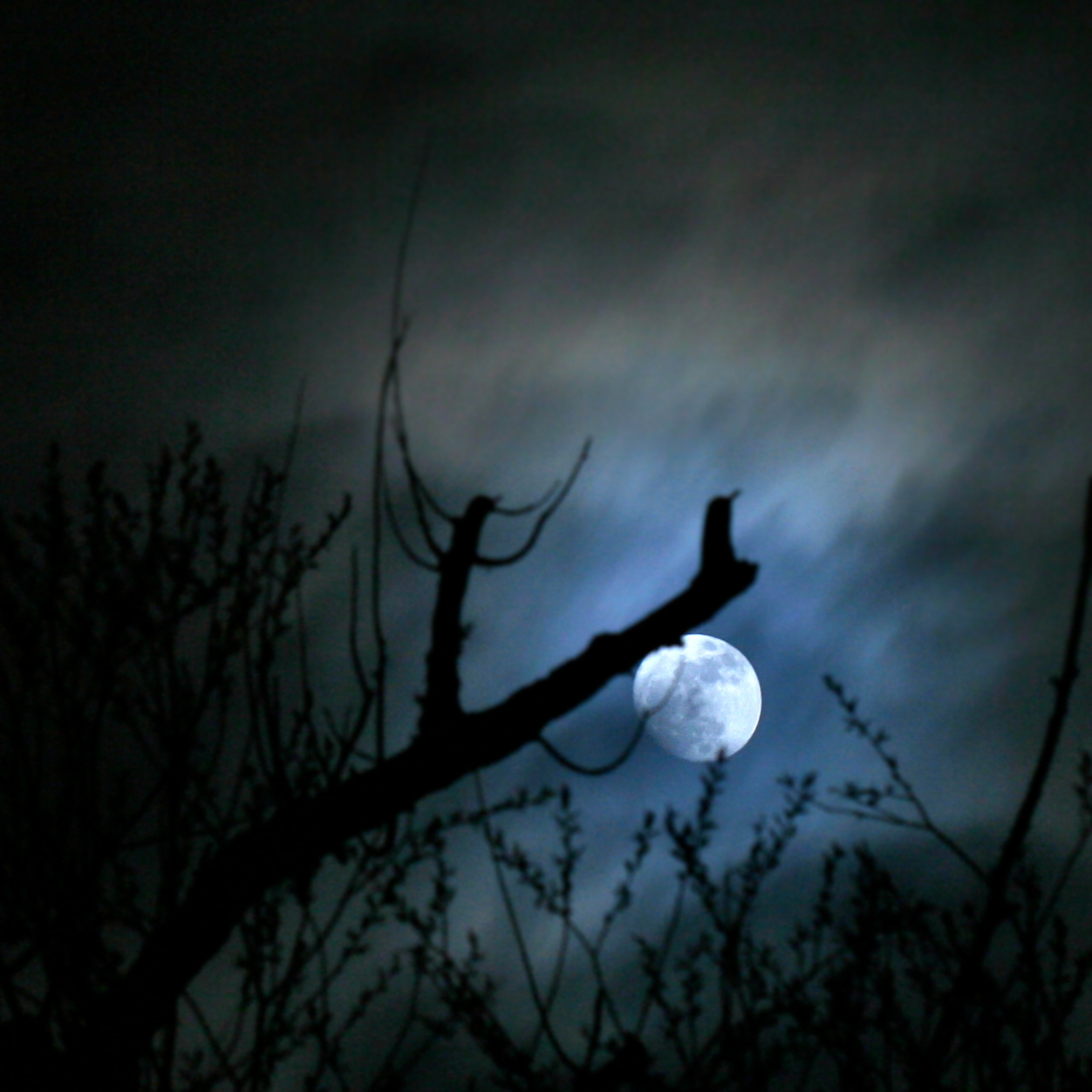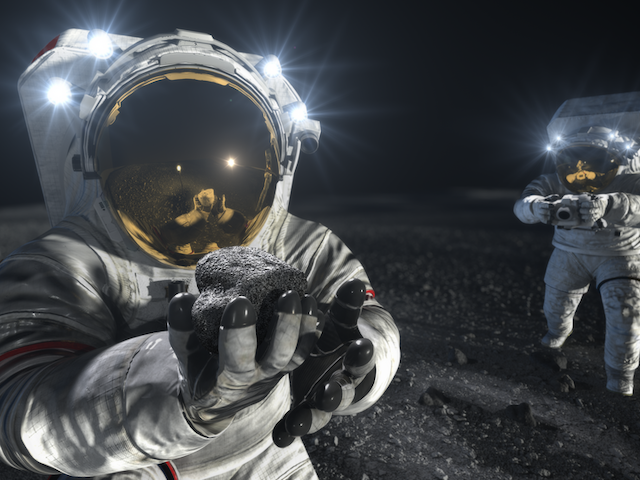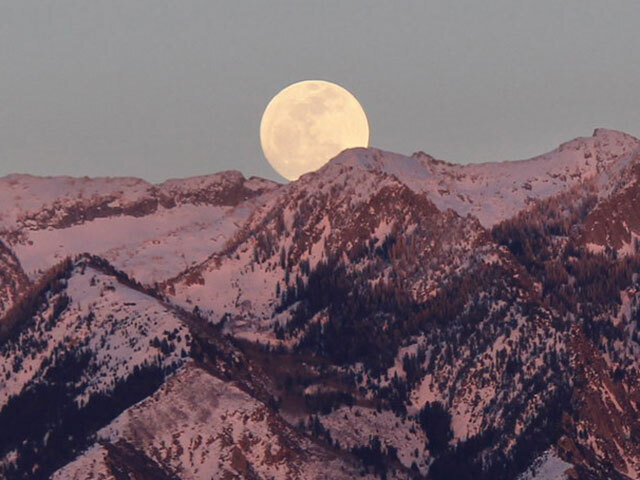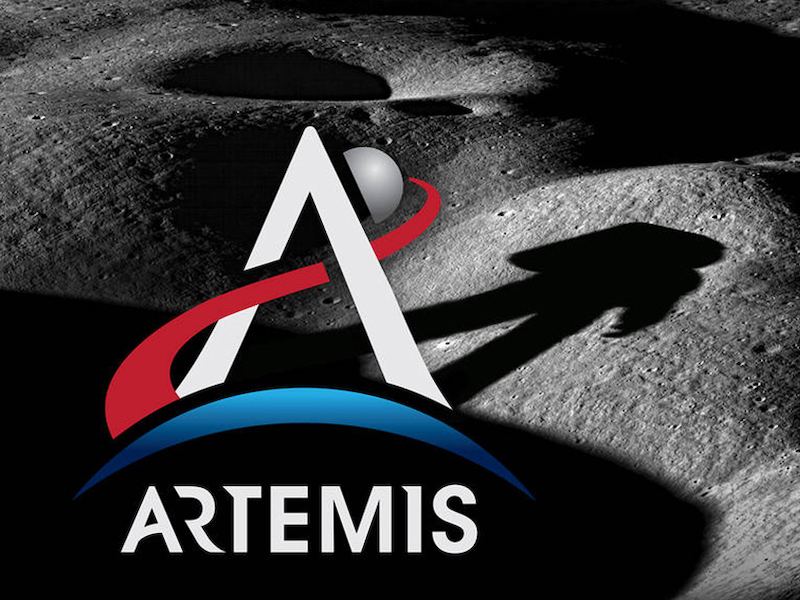News | May 25, 2018
Full Moon Blog: The Next Full Moon is the Strawberry Moon

Image Credit: NASA/Bill Dunford
The next full Moon will be on Tuesday morning, May 29, 2018, appearing "opposite" the Sun (in Earth-based longitude) at 10:20 AM EDT. The Moon will appear full for about three days around this time, from Sunday night through Wednesday morning (and possibly early Wednesday evening).
The Maine Farmer's Almanac first published Native American names for the full Moons in the 1930's. According to this almanac, the last full Moon of Spring is known as the Strawberry Moon, a name universal to just about every Algonquin tribe. The name comes from the relatively short season for harvesting strawberries in northeastern North America. For my back yard at least, I can attest that the strawberries are coming in!
In lunisolar calendars the months change with the new Moon and full Moons fall in the middle of the lunar months. This full Moon is the middle of the fourth month of the Chinese calendar and Sivan in the Hebrew calendar. In the Islamic calendar the months start with the first sighting of the waxing crescent Moon a few days after the New Moon. This full Moon is near the middle of the holy month of Ramadan, the month in which the Quran was revealed. Observing this annual month of charitable acts, prayer, and fasting from dawn to sunset is one of the Five Pillars of Islam.
As usual, the wearing of suitably celebratory celestial attire is encouraged in honor of the full Moon.
As for other celestial events between now and the full Moon after next:
As Spring ends and Summer begins, the daily periods of sunlight will reach their longest. For the Washington, DC area, on the day of the full Moon at the end of May, morning twilight will begin at 4:36 AM, sunrise will be at 5:46 AM, the Sun will reach a maximum altitude of 72.8 degrees at 1:06 PM, sunset will be at 8:25 PM, and evening twilight will end at 9:36 PM EDT.
Rounded to the minute, the earliest sunrises of the year (5:42 AM EDT) will be from Sunday, June 10, to Sunday, June 17, 2018. The latest sunsets of the year (rounded to the minute) will be at 8:37 PM EDT from Wednesday, June 20 until Thursday, July 5, 2018. The Summer Solstice will be on Thursday, June 21, 2018, at 6:07 AM EDT, and this will be the day with the longest period of sunlight, 14 hours, 53 minutes, and 40.9 seconds. On the day of the Solstice, morning twilight will begin at 4:30 AM, sunrise will be at 5:43 AM, the Sun will reach a maximum altitude of 74.6 degrees at 1:10 PM, sunset will be at 8:37 PM, and evening twilight will end at 9:49 PM EDT.
Rounded to the minute, the earliest sunrises of the year (5:42 AM EDT) will be from Sunday, June 10, to Sunday, June 17, 2018. The latest sunsets of the year (rounded to the minute) will be at 8:37 PM EDT from Wednesday, June 20 until Thursday, July 5, 2018. The Summer Solstice will be on Thursday, June 21, 2018, at 6:07 AM EDT, and this will be the day with the longest period of sunlight, 14 hours, 53 minutes, and 40.9 seconds.
By the day of the full Moon at the end of June, morning twilight will begin at 4:33 AM, sunrise will be at 5:45 AM, the Sun will reach a maximum altitude of 74.4 degrees at 1:11 PM, sunset will be at 8:37 PM, and evening twilight will end at 9:50 PM EDT.
On the evening of the full Moon at the end of May, as evening twilight ends, the bright planet Venus as the evening star will appear in the west-northwest, about 15 degrees above the horizon. Not as bright as Venus, but still bright, will be the planet Jupiter, just past its brightest for the year, appearing about 29 degrees above the horizon in the southeast. The bright planet Saturn will be rising in the east-southeast at 10:26 PM, and will be at its brightest for the year at the end of June. The planet Mars will not rise until after midnight. By mid-June the planet Mercury will begin to be visible about 30 minutes after sunset in the west-northwest and by late June will be above the horizon at the time evening twilight ends. By the evening of the full Moon at the end of June, as evening twilight ends, Jupiter will have shifted to about 36 degrees above the southern horizon, Saturn will appear about 14 degrees above the southeastern horizon, and Mercury will appear about 2.5 degrees above the horizon in the west-northwest.
On the morning of the late May full Moon, as morning twilight begins, bright Saturn will appear in the south-southwest about 26 degrees above the horizon, Mars will appear to the left of Saturn about 29 degrees above the horizon in the south-southeast, and bright Jupiter will be setting in the west-southwest. The "Summer Triangle" will appear almost directly overhead. The "Summer Triangle" is not a constellation but consists of three bright stars from three different constellations; Deneb, the brightest star in the constellation Cygnus the Swan; Vega, the brightest star in the constellation Lyra the Harp; and Altair, the brightest star in the constellation Aquila the Eagle. By the morning of the late June full Moon, as morning twilight begins, Jupiter will have already set, Saturn will appear about 12 degrees above the horizon in the southwest, and Mars will appear about 27 degrees above the horizon in the south-southwest. The "Summer Triangle" will appear high in the west.
This summer will be great time for Jupiter and Saturn watching, especially with a backyard telescope. Jupiter was at its closest and brightest for the year on May 8 2018, and Saturn will be at its closest and brightest the morning of June 27, 2018 (called "opposition" because it is opposite the Earth from the Sun, effectively a "full Saturn"). Both will appear to shift towards the west over the coming months, making them visible earlier in the evening sky. With a small telescope you will be able to see Jupiter's four bright moons, Ganymede, Callisto, Europa, and Io, shifting positions noticeably in the course of an evening. Galileo was the first person known to point the newly developed telescope at Jupiter, and he immediately noticed these moons that we now call the Galilean moons. For Saturn, you should be able to see the brightly illuminated rings as well as the motions of Saturn's moons, particularly the largest moon, Titan.
Even though they are not visible usually, I include in these Moon missives information about Near Earth Objects (mostly asteroids) that pass the Earth within about 15 lunar distances, because I find it interesting that we have discovered so many. On Friday evening, May 25, 2018, at 6:30 PM EDT (2018-May-25 22:30 UTC), Near Earth Object (2018 JG2), between 46 and 103 meters (152 to 339 feet) in diameter, will pass the Earth at between 18.3 and 18.5 lunar distances (nominally 18.4), traveling at 6.91 kilometers per second (15,448 miles per hour).
On Friday night, May 25, 2018, the bright star Spica will appear about 6 degrees to the lower right of the waxing gibbous Moon. For the Washington, DC area, evening twilight will end at 9:32 PM, the Moon will reach its highest in the sky for the night at 10:30 PM, and Spica will set Saturday morning at around 3:45 AM EDT.
On Sunday night into Monday morning, May 27 to 28, 2018, the bright planet Jupiter will appear to the left of the nearly full Moon. For the Washington, DC area, evening twilight will end at 9:34 PM, the Moon will reach its highest in the sky for the evening just after midnight on Monday morning at 12:03 AM, and morning twilight will begin at 4:37 AM EDT.
On Monday afternoon, May 28, 2018, at 3:00 PM EDT (2018-May-28 19:00 UTC), Near Earth Object (2018 KR), between 14 and 31 meters (46 to 102 feet) in diameter, will pass the Earth at between 15.6 and 15.7 lunar distances (nominally 15.7), traveling at 4.03 kilometers per second (9,013 miles per hour).
On Monday night, May 28, 2018, at 10:46 PM EDT (2018-May-29 02:46 UTC), Near Earth Object 68347 (2001 KB67), between 291 and 652 meters (956 to 2,138 feet) in diameter, will pass the Earth at 9.5 lunar distances, traveling at 13.34 kilometers per second (29,838 miles per hour).
As mentioned above, the next full Moon will be on Tuesday, May 29, 2018, at 10:20 AM EDT.
On Tuesday, May 29, 2018, at 11:11 AM EDT (2018-May-29 15:11 UTC), Near Earth Object (2018 KN2), between 21 and 47 meters (69 to 155 feet) in diameter, will pass the Earth at 6.1 lunar distances, traveling at 8.04 kilometers per second (17,983 miles per hour).
On Thursday morning, May 31, 2018, at 1:05 AM EDT (2018-May-31 05:05 UTC), Near Earth Object (2013 LE7), between 9 and 20 meters (29 to 65 feet) in diameter, will pass the Earth at 17.7 lunar distances, traveling at 1.72 kilometers per second (3,850 miles per hour).
On Thursday night, May 31, 2018, the bright planet Saturn will appear less than 2 degrees to the right of the nearly full Moon. For the Washington, DC area, the Moon and Saturn will rise together in the east-southeast at 10:17 PM. They will appear to shift apart slightly as the night progresses. The Moon will reach its highest in the sky Friday morning at 3:16 AM, and morning twilight will begin at 4:34 AM EDT.
On Friday morning, June 1, 2018, at 2:09 AM EDT (2018-Jun-01 06:09 UTC with 2 minutes uncertainty), Near Earth Object (2018 KE1), between 24 and 54 meters (80 to 178 feet) in diameter, will pass the Earth at between 10.6 and 10.9 lunar distances (nominally 10.8), traveling at 16.21 kilometers per second (36,250 miles per hour).
Saturday night, June 2, 2018, at 12:34 PM EDT, the Moon will be at apogee, its farthest from the Earth for this orbit.
Saturday night, June 2, into Sunday morning, June 3, 2018, the planet Mars will appear below the waning crescent Moon. For the Washington, DC area, the Moon will rise in the east-southeast at 11:47 PM, Mars will rise 23 minutes later, on Sunday morning at 12:10 AM, and morning twilight will begin at 4:33 AM EDT.
Saturday evening, June 5, 2018, the planet Mercury will pass on the far side of the Sun as seen from Earth, called superior conjunction. Later in June Mercury will begin to emerge from the glow of sunset in the west-northwest.
Thursday night, June 7, 2018, the waning Moon will appear half-full as it reaches its last quarter at 11:37 PM EDT.
On Sunday afternoon, June 10, 2018, at 3:17 PM EDT (2018-Jun-10 19:17 UTC with 1 minute uncertainty), Near Earth Object (2018 EJ4), between 146 and 327 meters (479 to 1,072 feet) in diameter, will pass the Earth at 5.6 lunar distances, traveling at 6.18 kilometers per second (13,831 miles per hour).
On Monday morning, June 11, 2018, at 1:53 AM EDT (2018-Jun-11 05:53 UTC), Near Earth Object (2015 DP155), between 127 and 284 meters (417 to 933 feet) in diameter, will pass the Earth at 9.0 lunar distances, traveling at 4.42 kilometers per second (9,878 miles per hour).
Wednesday afternoon, June 13, 2018, at 3:43 PM EDT, will be the new Moon, when the Moon passes between the Earth and the Sun and will not be visible from the Earth. In most lunisolar calendars the new month starts with the New Moon. In the Hebrew calendar days start with sunset, so Wednesday evening marks the start of Tammuz in the Hebrew calendar. In the traditional Chinese calendar days begin at midnight and the day of the New Moon is the first day of the new month, but because China is 12 hours ahead of EDT, the fifth month in the Chinese calendar starts on June 14, 2018.
Thursday evening, June 14, 2018, at 7:55 PM EDT, the Moon will be at perigee, its closest to the Earth for this orbit.
In the Islamic calendar the months start with the first sighting of the waxing crescent Moon after the New Moon. The first day of Shawwal, with the signing of the crescent Moon the evening of Thursday, June 14, 2018, should mark the end of the holy month of Ramadan and is celebrated with Eid al-Fitr, the festival of breaking the fast. For the Washington, DC area, sunset will be at 8:35 PM, and the thin crescent Moon should be visible for about the last half-hour before it sets at 9:34 PM EDT.
On Friday, June 15, 2018, the thin, waxing, crescent Moon will appear below the bright planet Venus near the horizon in the west-northwest. For the Washington, DC area, evening twilight will end at 9:48, the Moon will set at 10:33 PM, and Venus will set at 11:10 PM EDT.
By Saturday, June 16, 2018, the waxing crescent Moon will appear to have shifted to appear to the left of and a little above Venus. For the Washington, DC area, evening twilight will end at 9:48 PM, Venus will set at 11:10 PM, and the Moon will set at 11:25 PM EDT.
Sunday evening, June 17, 2018, the bright star Regulus will appear in the west to the upper left of the waxing crescent Moon. For the Washington, DC area, evening twilight will end at 9:48 PM, the Moon will set Monday morning at 12:09 AM, and Regulus will set 5 minutes later at 12:14 AM EDT.
Monday, June 18, 2018, is the fifth day of the fifth month of the traditional Chinese calendar, the day of the Dragon Boat Festival.
On Wednesday morning, June 20, 2018, the Moon will appear half-full as it reaches its first quarter at 6:51 AM EDT.
The Summer Solstice, the astronomical end of Spring and start of Summer, will be Thursday morning, June 21, 2018, at 6:07 AM EDT.
On Thursday afternoon, June 21, 2018, at 4:54 PM EDT (2018-Jun-21 20:54 UTC with 2 minutes uncertainty), Near Earth Object (2017 YE5), between 384 and 859 meters (1,260 to 2,819 feet) in diameter, will pass the Earth at 15.5 lunar distances, traveling at 15.47 kilometers per second (34,612 miles per hour).
Thursday evening, June 21, 2018, the bright star Spica will appear below and slightly to the left of the waxing gibbous Moon.
On Friday evening, June 22, 2018, at 9:05 PM EDT (2018-Jun-23 01:05 UTC), Near Earth Object 467309 (1996 AW1), between 266 and 594 meters (872 to 1,950 feet) in diameter, will pass the Earth at 17.9 lunar distances, traveling at 13.99 kilometers per second (31,303 miles per hour).
Saturday evening, June 23, 2018, the bright planet Jupiter will appear to the lower right of the waxing gibbous Moon.
On Sunday morning June 24, 2018, at 5:06 AM EDT (2018-Jun-24 09:06 UTC), Near Earth Object 441987 (2010 NY65), between 133 and 298 meters (437 to 977 feet) in diameter, will pass the Earth at 7.3 lunar distances, traveling at 12.58 kilometers per second (28,143 miles per hour).
Monday evening, June 25, 2018, the bright star Antares will appear below and a little to the right of the nearly full waxing gibbous Moon.
Wednesday morning, June 27, 2018, Saturn will be at opposition, or opposite the Sun as seen from the Earth, effectively a "full" Saturn that rises around sunset and sets around sunrise. This is when Saturn will be at its closest and brightest for the year. With good binoculars or a small telescope, you should be able to see clearly the rings of Saturn and Saturn's large moon Titan, that has an atmosphere and seas of liquid methane.
Wednesday evening into Thursday morning, June 27 to 28, 2018, the bright planet Saturn, nearly at its brightest and closest to the Earth for the year, will appear below the full Moon. The pair will appear at their closest at around 11 PM EDT.
The full Moon after next will be just after midnight on Thursday morning, June 28, 2018, at 12:53 AM EDT.






